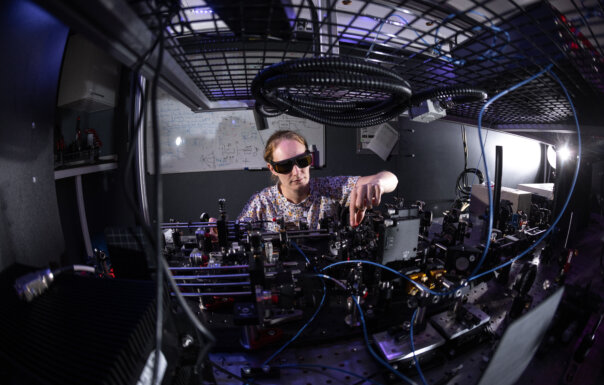LONDON — Quantum computing is more than just a dream for scientists and engineers: it is a reality that awaits us. When we arrive at this reality that was once sci-fi fodder remains the question. Now, for the first time, researchers have successfully created an interface that allows for two machines to connect and share stored quantum information, essentially the first tangible steps towards a “quantum internet.” The feat was also achieved at a wavelength compatible with the optical fiber system we use today for telecommunications.
The breakthrough takes us closer to a world where information can be transmitted with absolute security, and complex computations can be performed at lightning speed. This is the promise of quantum technologies, which harness the bizarre properties of quantum mechanics, such as superposition and entanglement. However, realizing this potential requires the ability to transfer and store quantum information, which is typically carried by single particles of light called photons.
One of the most promising platforms for generating these photons is semiconductor quantum dots – tiny islands of material that can emit light with unique quantum properties. These quantum dots are like artificial atoms, and can be engineered to produce photons on demand, making them ideal candidates for quantum communication protocols. However, to build a functional quantum network, these photons need to be stored and processed, which is where atomic quantum memories come in. These memories use ensembles of atoms to absorb and store the quantum state of light, allowing it to be retrieved at a later time. The challenge lies in getting these two systems to talk to each other effectively.
Next, they fine-tuned the properties of the light, using a series of filters and modulators to match its spectral and temporal profile to the requirements of the atomic memory. The memory itself is based on a protocol called ORCA (Off-Resonant Cascaded Absorption), which uses a cloud of rubidium atoms. When a strong control pulse of light is applied, it dynamically changes the absorption properties of the atoms, allowing them to store the quantum state of the incident photon.
The team demonstrated that they could store single photons from the quantum dot in the rubidium memory with an efficiency of 12.9%, and retrieve them at a later time of their choosing. Importantly, the retrieved photons retained their quantum character, with a signal-to-noise ratio of 18.2. This means that the memory can store and release the fragile quantum information carried by the photons without significant degradation.
This research, published in the journal Science Advances, represents a significant step towards the realization of hybrid quantum networks, where different quantum systems are interconnected to perform complex tasks. By interfacing solid-state photon emitters with atomic memories, we can envision a future where quantum information is generated, transmitted, stored, and processed across a distributed network, much like classical information is today across the internet.
“Interfacing two key devices together is a crucial step forward in allowing quantum networking, and we are really excited to be the first team to have been able to demonstrate this,” Thomas says in a media release.
However, there are still challenges to overcome. The efficiency of the storage and retrieval process needs to be improved, and the storage time of the memory needs to be extended. The researchers are already working on techniques to enhance these parameters, such as using dynamic control fields to compensate for the motion of the atoms, which currently limits the memory lifetime.
Furthermore, to truly scale up these systems, it will be necessary to integrate them on chip-based platforms, where multiple quantum dots and memories can be connected via waveguides and switches. This will require advances in nanofabrication and materials science, as well as the development of new interface protocols.
Despite these challenges, the potential payoff is immense. Quantum networks could enable applications such as unhackable communication, distributed quantum computing, enhanced sensing and metrology, and fundamental tests of quantum mechanics over large scales. By bringing together the best of solid-state and atomic physics, this work opens the door to a new era of quantum technologies.
“Members of the quantum community have been actively attempting this link for some time. This includes us, having tried this experiment twice before with different memory and quantum dot devices, going back more than five years, which just shows how hard it is to do,” says co-author Dr. Patrick Ledingham from the University of Southampton. “The breakthrough this time was convening experts to develop and run each part of the experiment with specialist equipment and working together to synchronize the devices.”
The exciting experiment demonstrates the feasibility of storing and retrieving single photons from a quantum dot in an atomic quantum memory. It showcases the power of hybrid quantum systems, and the potential for telecommunications band operation – a key requirement for real-world applications. As we continue to push the boundaries of quantum science and engineering, such hybrid interfaces will play a crucial role in realizing the full potential of quantum technologies. The future of quantum networking is bright, and it’s getting brighter one photon at a time.

